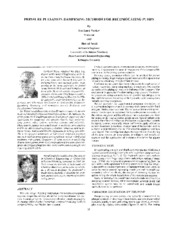| dc.contributor.other | International Pump Users Symposium (10th : 1993) | |
| dc.creator | Vetter, Gerhard | |
| dc.creator | Seidl, Bernd | |
| dc.date.accessioned | 2017-10-05T17:12:32Z | |
| dc.date.available | 2017-10-05T17:12:32Z | |
| dc.date.issued | 1993 | |
| dc.identifier.uri | https://hdl.handle.net/1969.1/164214 | |
| dc.description | Lecture | en |
| dc.description | pg. 25 | en |
| dc.description.abstract | The safe design of piping installations for reciprocating pumps requires proper knowledge about the pump installation interaction. A compact review shows pump vibration spectra excited by the pumps and methods of numerical computation taking the fluid compressibility and friction into account. Critical operation occurs in resonance situations where excitement by the pump and the natural frequencies of the compressible continuum in the piping system coincide. In many cases, resonance effects can be avoided by proper piping geometry, improved pump performance with respect to the volumetric efficiency or higher fluid friction. If all primary measures have been exhausted, the application of various secondary dampening methods is necessary because the acoustics of the piping system can be influenced. In the range of the excitement frequencies of reciprocating pumps, most of the damper systems are acting as elastic elements (exhibiting spring action) that shift the natural frequency of the hydraulic system away from the initially existing resonances. Several examples for experimental computer simulations of damper action (upstream and downstream) are presented for fluid and gas filled damper versions. The influence of the entry geometry of the dampers explained, hunts of the proper geometry of the entries are given and the effects of various dampers and their influence on the total acoustics are discussed. Special reference is made to the effects of orifices as dissipative and acoustic elements in piping systems, especially where and how to apply orifices to reduce resonance pulsations, change natural frequencies and to achieve helpful filtering effects. The report is supplemented by a case history. The investigation shows the importance of analyzing of the total system of pump piping installation and vessels or reactors and the application of computer simulation for piping design. | en |
| dc.format.medium | Electronic | en |
| dc.format.mimetype | application/pdf | |
| dc.language.iso | en | |
| dc.publisher | Turbomachinery Laboratories, Department of Mechanical Engineering, Texas A&M University | |
| dc.relation.ispartof | Proceedings of the 10th International Pump Users Symposium | en |
| dc.subject.lcsh | Pumping machinery | en |
| dc.title | Pressure Pulsation Dampening Methods For Reciprocating Pumps | en |
| dc.type.genre | Presentation | en |
| dc.type.material | Text | en |
| dc.identifier.doi | https://doi.org/10.21423/R1DX22 | |


